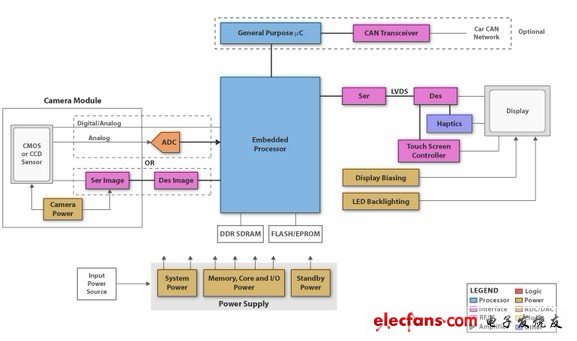Texas Instruments (TI) automotive vision control solutions
Design considerations
Vehicle vision control systems process data information from sources such as digital cameras, lasers, radars, and other sensors in order to perform tasks such as route departure prompts, doze sensing, or parking assistance. The processed information will be displayed on the display screen or broadcast through an audible warning signal.
Power management: The power supply is connected to the 12V or 24V stencil, and the voltage is adjusted up / down to be suitable for DSP, uC, memory and IC and other functions, such as stepper motor, communication interface, display deviation and background. When trying a small, low-cost, and efficient design, power supply design becomes a critical task because of the need for multiple different power rails. Linear regulator with low quiescent current helps to reduce battery leakage current during standby operation mode (turn off ignition). It is the load dump voltage tolerance of devices directly connected to the battery, requiring low voltage drop and tracking low battery crankshaft operating.

In addition to providing enhanced conversion efficiency, switching power supplies also provide conversion rate control of switching FETs, frequency hopping, spread spectrum or triangulation for attenuation of peak spectral energy, low Iq, for power sequencing and surges for EMI improvement Current-limited soft-start, phase-controlled switching for multiple SMPS regulators to reduce input ripple current and input capacitance, higher switching frequencies (of L and C) for smaller components, and for undervoltage Indicated SVS function
The communication interface allows data exchange between external electronic devices such as car independent electronic modules, remote submodules of infotainment systems, and USB memory or video sources. High-speed CAN (speed up to 1Mbps, ISO 119898) is a two-wire fault-tolerant differential bus. It has a wide input common-mode range and differential signal technology, serving as the main automotive bus type that interconnects various electronic modules in the car. LIN supports low-speed (up to 20kbps) single-bus wired networks and is mainly used to communicate with remote sub-functions of infotainment systems. The LVDS interface is used to transfer large amounts of data to a video screen or video source (digital camera chip) through a high-speed serial connection.
Display: Some car vision systems have display support functions, such as parking assistance. Depending on the display type, the power solution used to display the deviation needs to be placed on top of the LED or CCVF driver for backlight control. Video information can be sent directly from uC or through the LVDS interface, depending on the size of the displayed content.
Microprocessor: General uC handles system control functions and communication with other in-vehicle modules. The core digital function is the DSP, which is responsible for processing data from digital input sources (such as CCD cameras). It may require simple screen drivers to complex digital algorithms (such as pattern recognition), depending on the required performance. The MCU also needs a sufficiently high performance speed to serve the stepper motor in real time.
1.27Mm Female Header,1.27Mm Header Connector,Circuit Board Female Header Connector,Electronic Assemblies Male Right-Angle Connectors
Dongguan City Yuanyue Electronics Co.Ltd , https://www.yuanyueconnector.com